How Close Are We To A Vaccine Or Treatment For COVID-19?

Many different vaccines and drugs are being developed and tested at a record-busting pace, thanks to an unprecedented level of worldwide collaboration. However, it will likely take months to a year before we have a vaccine or drug.
By Dr Khor Ing Wei
Dean’s Office
Sadly, COVID-19 and the virus that causes it, SARS-CoV-2, need no introduction. Suffice to say, this has been a devastating pandemic like no other, redefining life and death in ways we have never seen before. What is more alarming, it may not be the last or even the worst pandemic to come our way. As the world slowly emerges out of lockdown and braces for a new normal, resumption of full commercial and social activities will depend on us having an effective COVID-19 vaccine and treatments for people who are already infected. So, how close are we to finding a vaccine and antiviral treatments?
To think about which treatments will work for COVID-19, we first need to understand how the disease progresses. In the earlier phase of COVID-19, the virus is reproducing rapidly and infecting host cells. Effective treatments in this phase will likely be those that prevent the virus from replicating itself or infecting cells. If the patient’s immune system is strong enough to clear the virus on its own, the disease stops there. This happens in 81% of COVID-19 cases.1 However, in 19% of cases, patients progress to a more severe phase of the disease, experiencing respiratory distress within 10 to 14 days after they first feel sick.1 In 5% of these cases, inflammation becomes the main problem, causing respiratory failure, sepsis, multiple organ failure and even death.2,3 Thus, different therapies that address inflammation are needed at this point.
When a candidate vaccine or antiviral drug is available, they must be tested in clinical trials with human subjects before they can be approved for use in humans.
Typically, a candidate therapeutic is tested in a relatively small number (<100) of healthy people to determine its safety (side effects and toxicity), sometimes in several dosages. This is called a Phase 1 clinical trial.4 If a therapeutic proves safe, it is then tested for efficacy and side effects in up to several hundred people with the targeted disease, and sometimes with a control group that receives placebo or the standard of care. This is called a Phase 2 clinical trial. If Phase 2 results are promising and severe side effects are absent or present in a relatively small number of patients, the next phase (Phase 3) testing involves many more patients (several hundreds to thousands) who may be at multiple testing sites. Phase 3 often includes a control group.
In the face of the devastating sickness and upheaval caused by the COVID-19 pandemic, scientists and clinicians have responded with an unprecedented level of collaboration, sharing data more openly than in any other time in recent memory. For example, in January 2020, Chinese scientists publically shared the genetic sequence of the SARS-CoV-2 virus. Equally important, government and non- profit organisations are providing large amounts of funding to pharmaceutical companies and research institutes, and collaborating across many countries, to accelerate development, clinical testing and production of the most promising vaccine and drug candidates.5 In some cases, candidates have been developed and clinical trials begun within a few months, compared with years or decades before the pandemic.
Vaccines
The world will not be able to fully open up again until we have an effective vaccine (or vaccines) that protects us against COVID-19, produced in large enough amounts to immunise large numbers of people.
As of July 2020, more than 120 candidate vaccines are under development, with the possibility of even more that have not been widely reported.6 Some of these vaccine candidates are currently being tested in clinical trials, while others are scheduled to start clinical testing later in 2020 (Table 1). Other candidate vaccines are at an earlier stage of preclinical development and are not discussed in this article.
Most of the vaccines currently in use are either whole virus vaccines, subunit vaccines or viral vector vaccines. Whole virus vaccines include the intact virus that is inactivated in some way (eg, by heat or chemicals) to make it less likely to replicate and cause disease. Subunit vaccines include a portion of the virus, usually a key protein or proteins. Viral vector vaccines incorporate a viral protein in another, more harmless virus which serves as a vehicle to stimulate the immune response. The spike (S) protein of SARS-CoV-2, which fuses with the host cell membrane and enables the virus to get into cells, is the obvious starting point for subunit vaccines. Scientists made an important finding that the pre- fusion form of the S protein is much more likely to provoke a strong neutralising antibody response than the post-fusion form.7
The “new kids on the block” are the DNA vaccines and mRNA vaccines. Large-scale production may be quicker and less expensive for these vaccines because they are less complex than virus, subunit or viral vector vaccines. However, the current batch of clinical trials represent the first time they are being tested in humans.
The various vaccines are also projected to have different effects on the immune system. Some vaccines aim to induce neutralising antibodies (traditionally the holy grail of vaccine response), while others aim to induce both neutralising antibodies and T cells (potentially a more effective dual response). As opposed to “regular” antibodies, neutralising antibodies are those that bind to the virus and prevent it from infecting cells. However, we will have to wait for results from the clinical trials to know for sure how the human immune system will respond to each of these vaccines.
After a safe and effective vaccine is identified, large amounts of it will need to be produced. Usually, a promising vaccine candidate would be identified after clinical trials, and only at that point would it be manufactured at scale. However, the urgent needs caused by the pandemic means that this stage has to be acclerated as well. Some pharmaceutical companies have manufactured or are planning to manufacture large amounts of their vaccine candidates, while they are still undergoing clinical trials. This way, if the candidate proves to be a safe and effective vaccine, it would already be produced in large quantities and can be quickly used to vaccinate populations.
Moderna, the company developing the mRNA vaccine that has shown promising results in Phase 1 trials, has received almost half a billion USD from the U.S. government to ramp up efforts and produce large quantities of its vaccine if its later trial results are also promising. The Coalition for Epidemic Preparedness Innovations (CEPI) (which is funded by several European countries, Canada, Saudi Arabia and the Bill and Melinda Gates Foundation) has contributed hundreds of millions of dollars to accelerate clinical trial testing and manufacturing of several promising vaccine candidates.
Table 1.
Some of the vaccine candidates currently being developed8,9
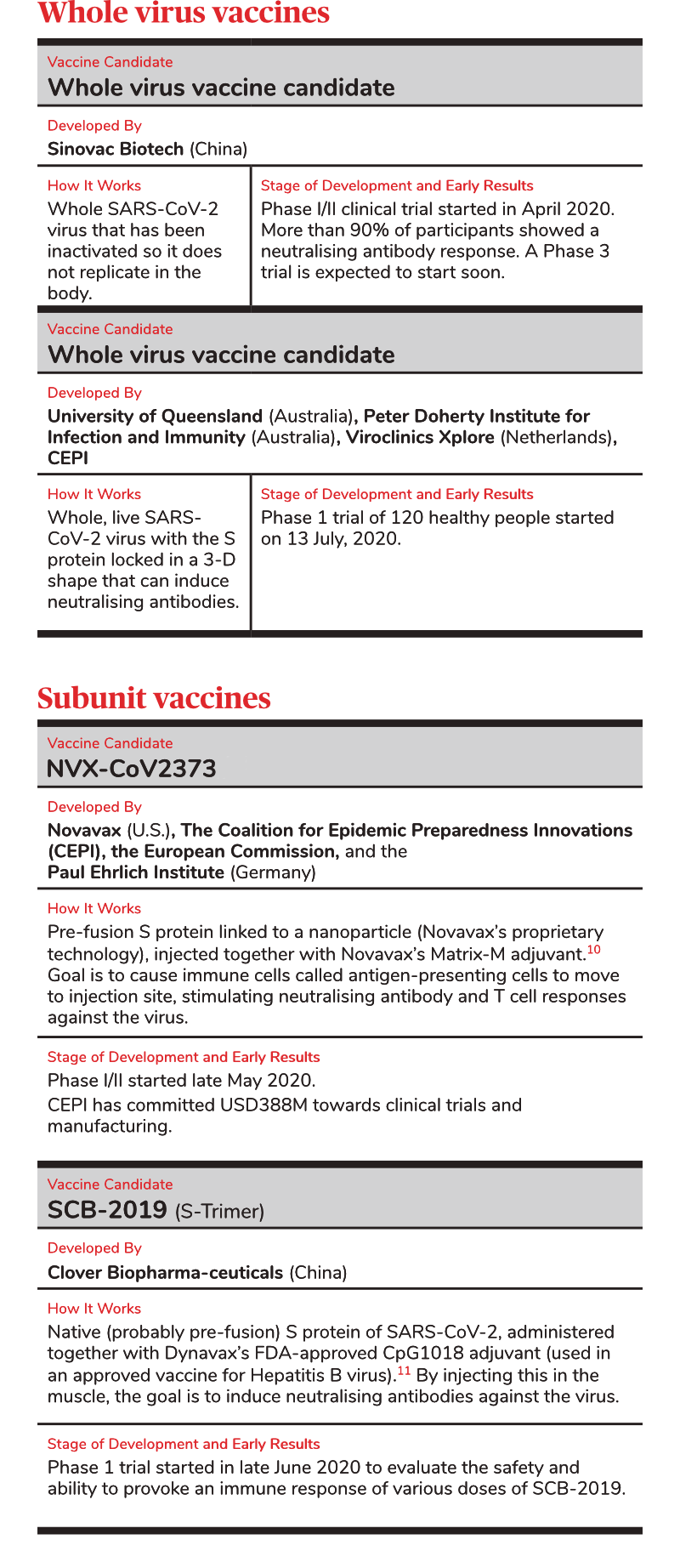
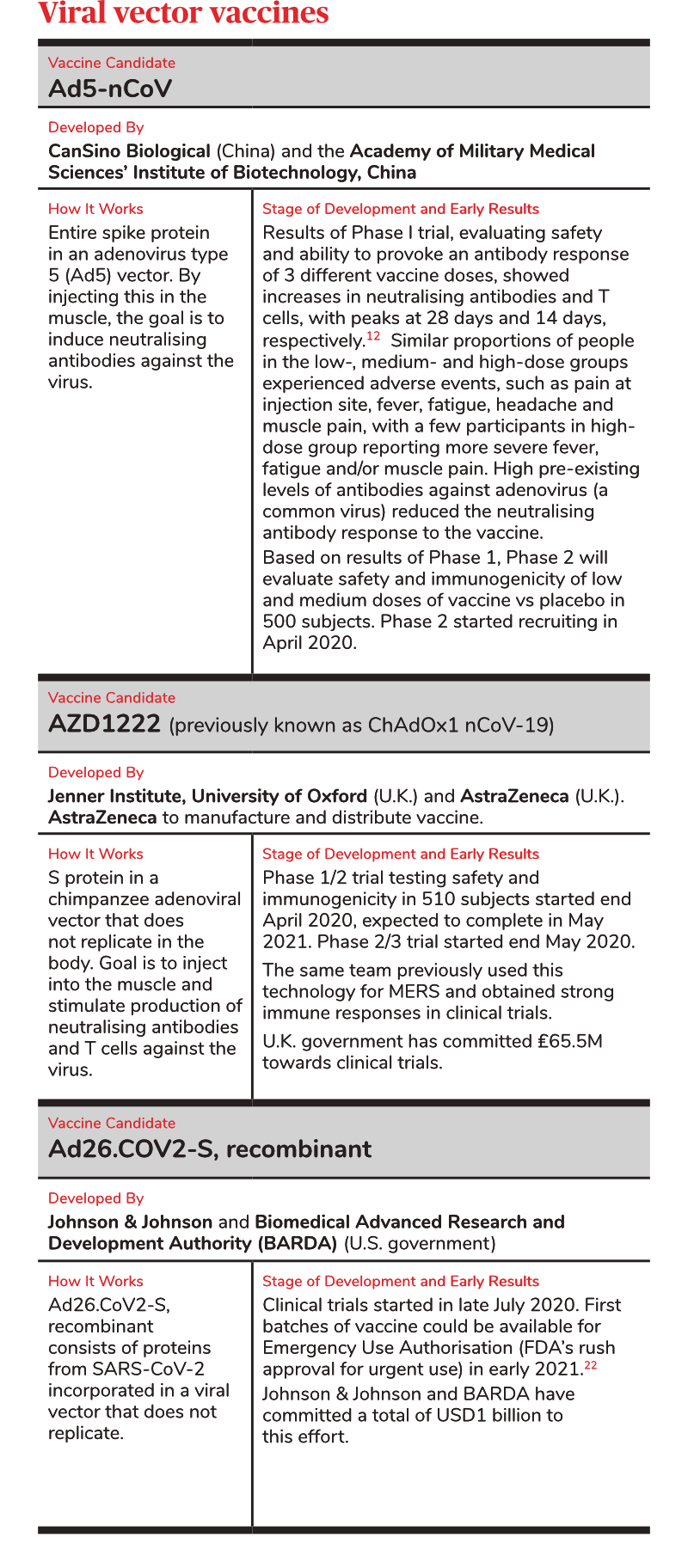
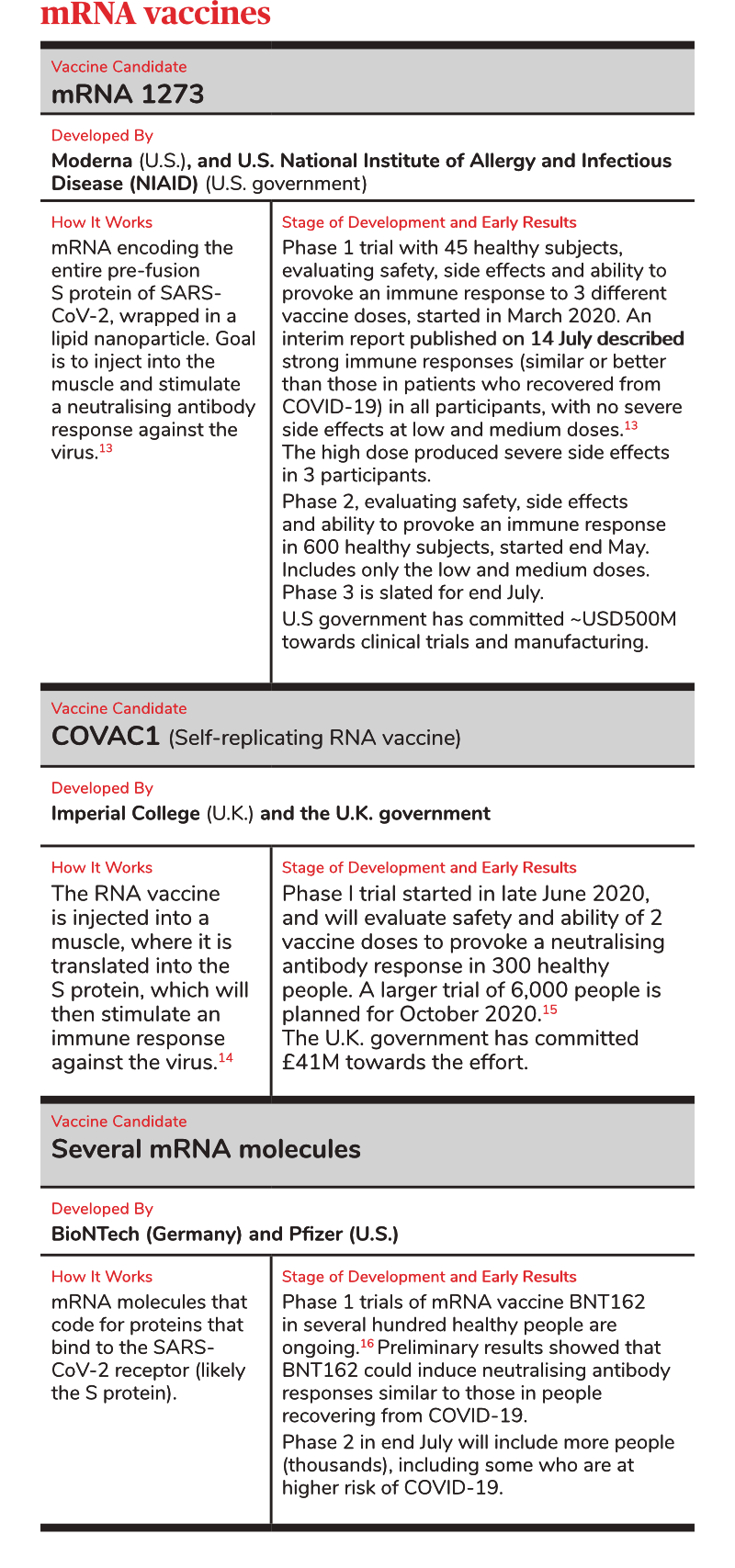

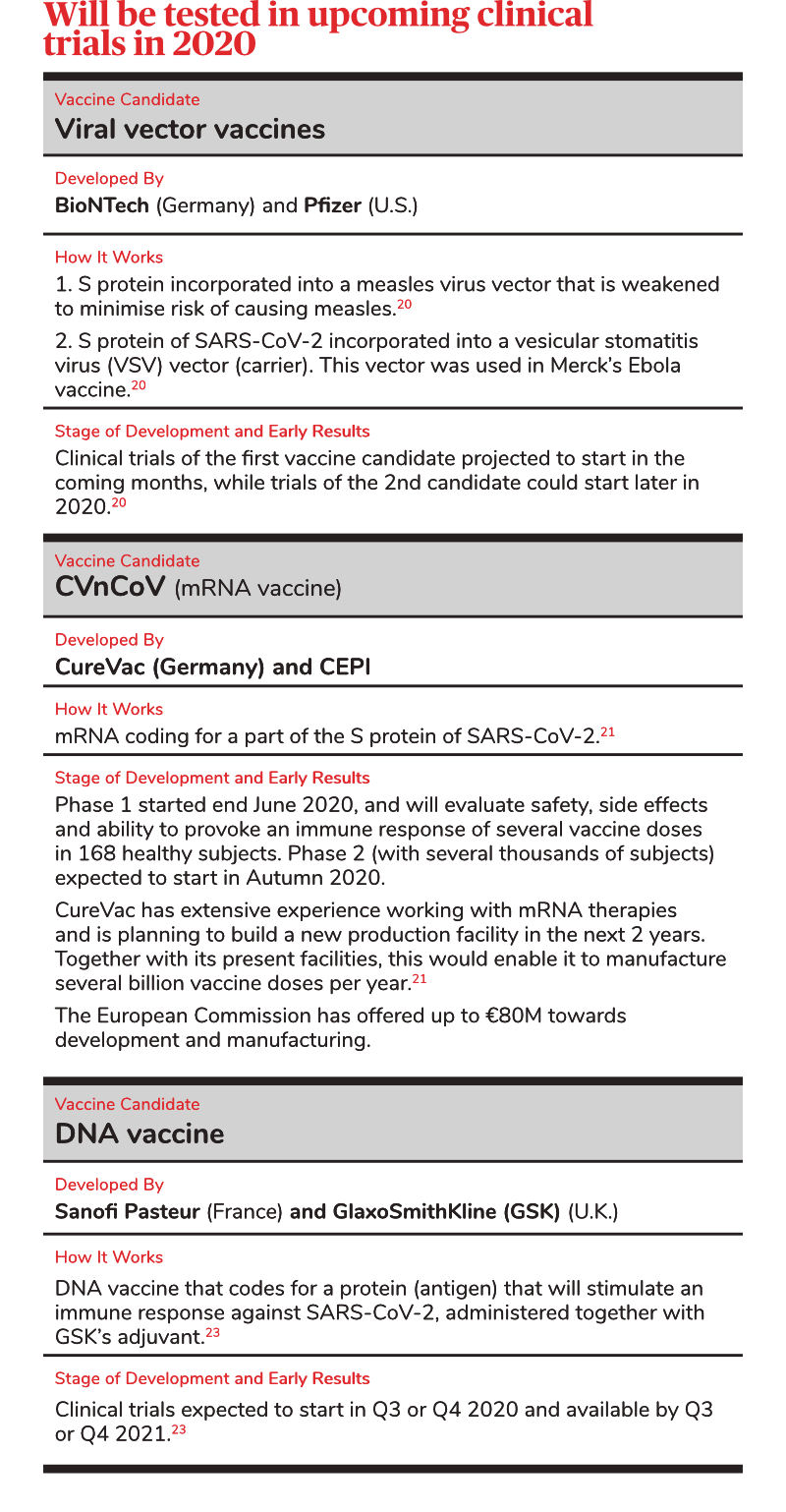
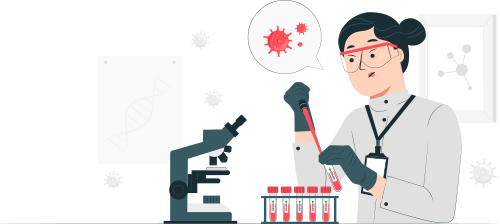
Antivirals
While vaccines are typically used to protect healthy people from getting sick with COVID-19, antiviral drugs can also be used to treat people who already have the disease. Some antiviral drugs prevent the virus from infecting cells, which is the first step in establishing an infection. Other antivirals work by binding to virus particles already present in a person, targeting the virus for destruction by the immune system. Yet other antiviral drugs suppress the inflammatory response and are mainly effective in more severe COVID-19 infections, in which inflammation is a major problem. Most of the antivirals that are currently being tested or that are scheduled for testing in 2020 are antibodies or small molecules, a class of chemical compounds (Table 2).
One small molecule, remdesivir, was originally developed to treat Ebola virus infection. It has since emerged as one of the most promising antiviral candidates, speeding up recovery in hospitalised COVID-19 patients in an early report (Table 2). Singapore is playing an important role in the development of remdesivir as a COVID-19 treatment, with COVID-19 patients here involved in three clinical trials of the drug. Using an innovative AI tool, NUS researchers have also predicted that remdesivir, together with lopinavir and ritonavir (an HIV drug combination) may just be the deadly cocktail that takes down SARS-CoV-2.
Antibodies isolated from the blood of patients who have recovered from COVID-19 can be potent antiviral agents, useful for protecting people against infection and treating the disease in COVID-19 patients.
One such antibody, AOD01, was identified from screening B cells (the cells that produce antibodies) as part of a Singapore whole-of-government effort, involving scientists at the DSO National Laboratories and the NUS Yong Loo Lin School of Medicine, as well as collaborators at the Ministry of Defence, Ministry of Health and the Economic Development Board. AOD01 had one of the highest neutralising activities against SARS-CoV-2 reported to date in cell culture (the ability to block the virus from infecting cells). A clinical trial of AOD01 is planned in the coming months.
Another candidate, APN01, is neither an antibody or a small molecule. Instead, it is a protein that mimics the receptor used by SARS-CoV-2 to enter cells in the body. The hope is that APN01 will bind to the virus, thus preventing the virus from binding to its receptor and infecting cells.
Repurposing Drugs As Antivirals
One way to speed up the process of obtaining drugs that can be used in humans is to repurpose existing drugs, which have already been tested in clinical trials and approved by regulatory authorities for other diseases. Several of the antivirals that are being tested in COVID-19 clinical trials are repurposed antibodies or small molecules that were originally developed for diseases such as HIV, Ebola and inflammatory arthritis (Table 2).
Table 2.
Some of the antiviral drug candidates currently being developed
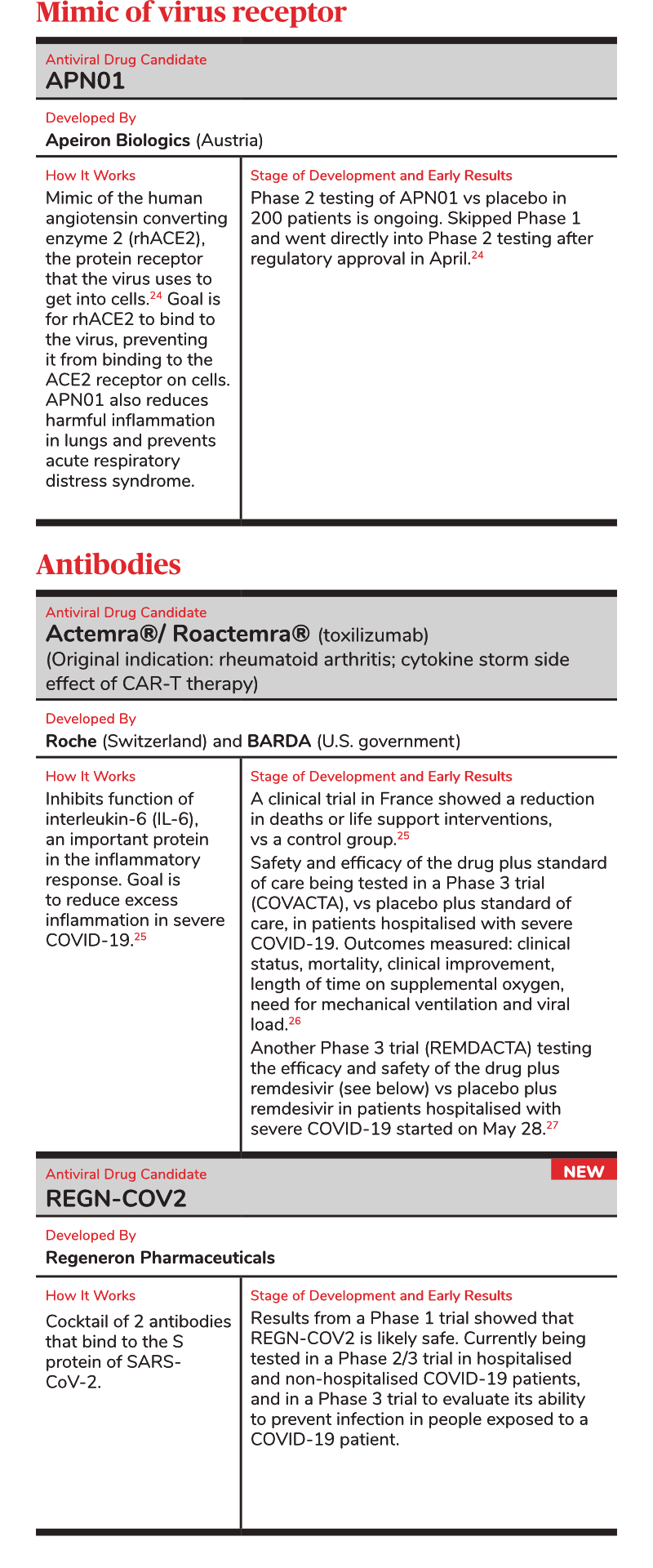
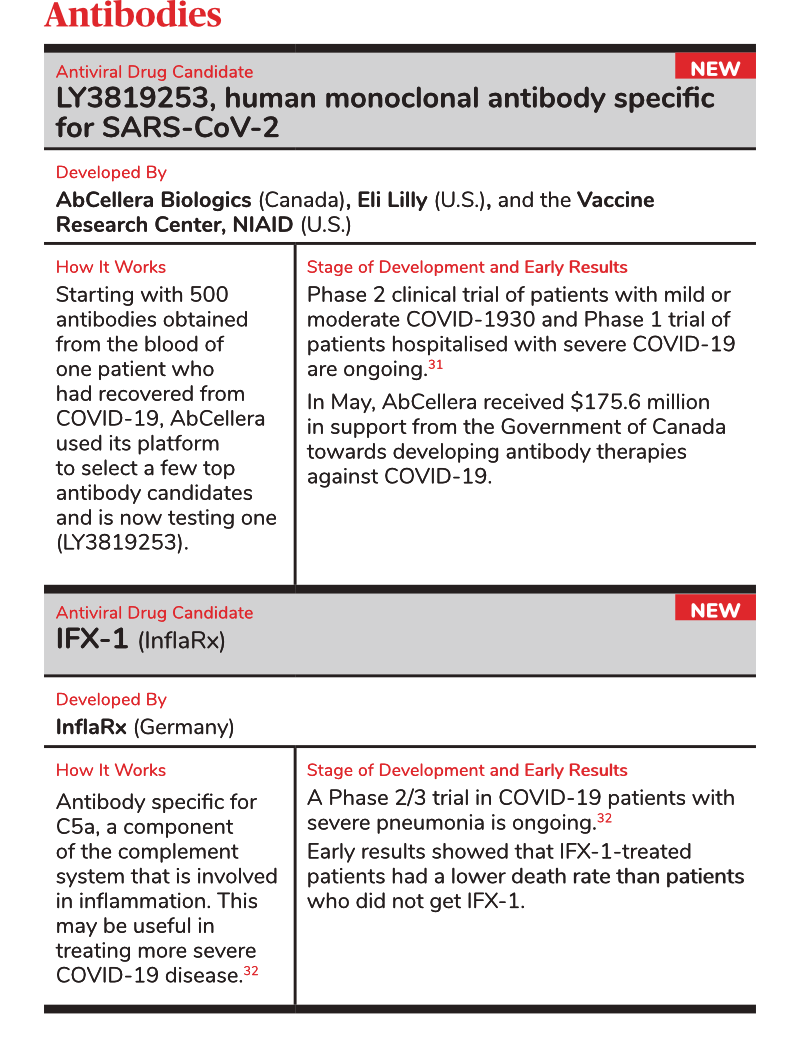

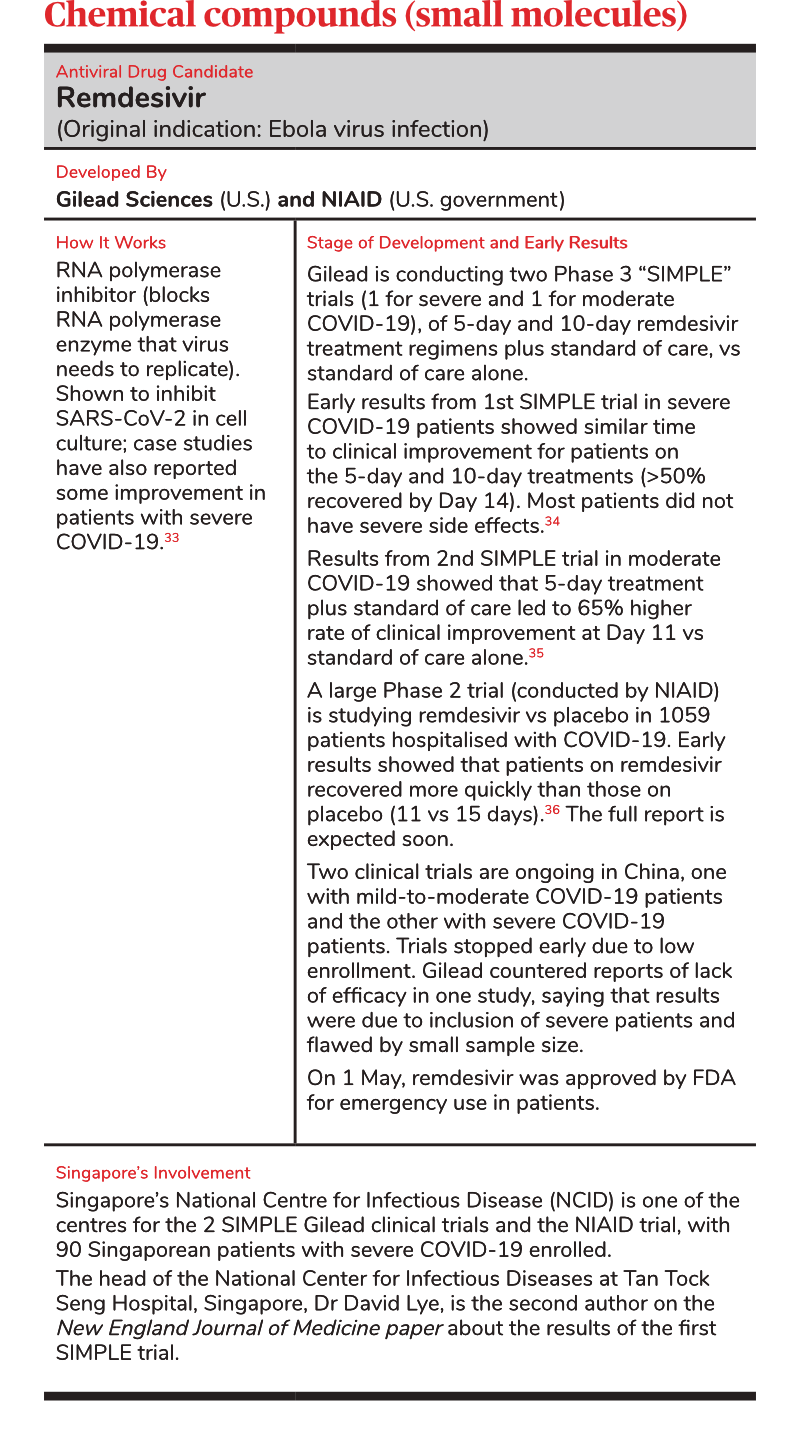
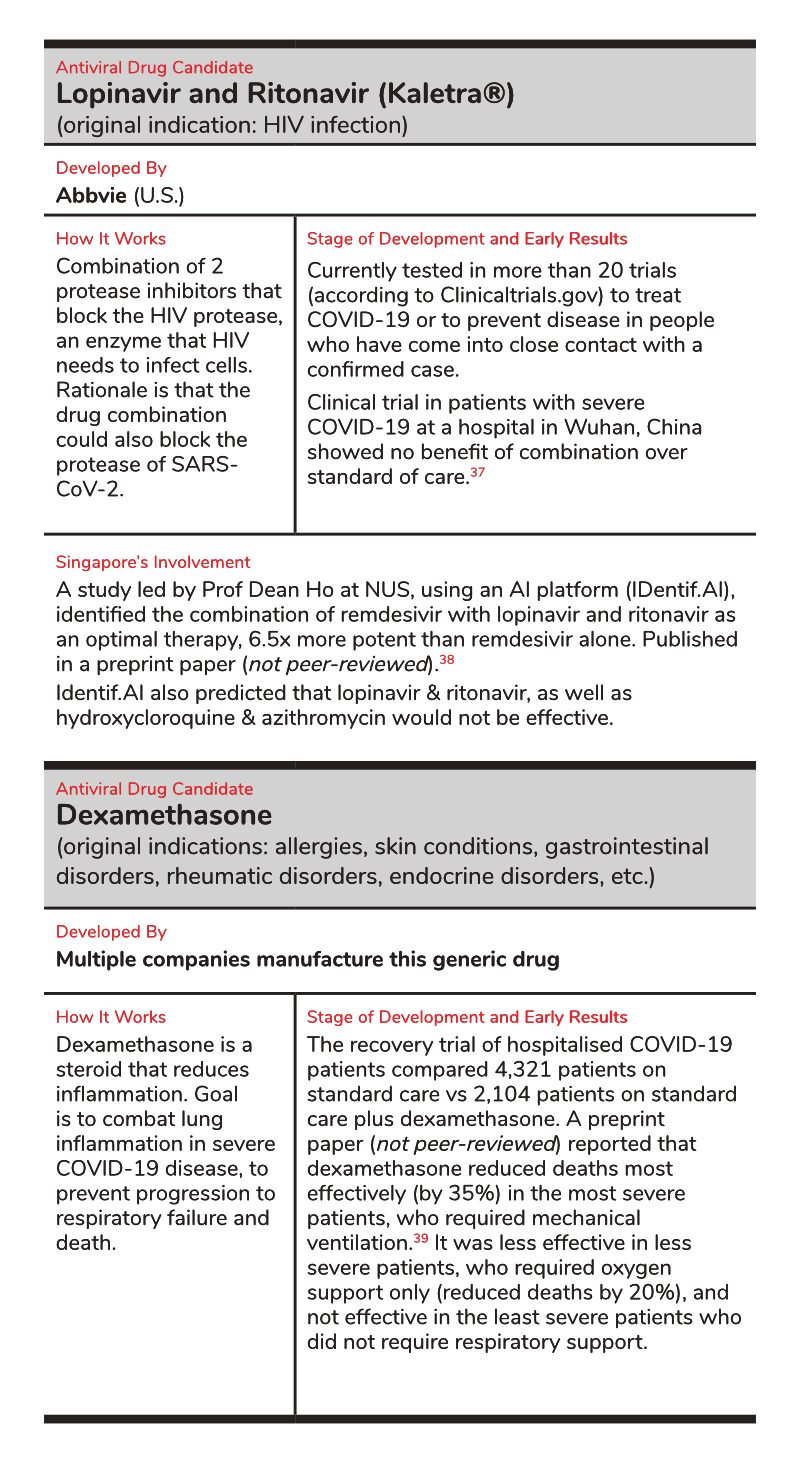
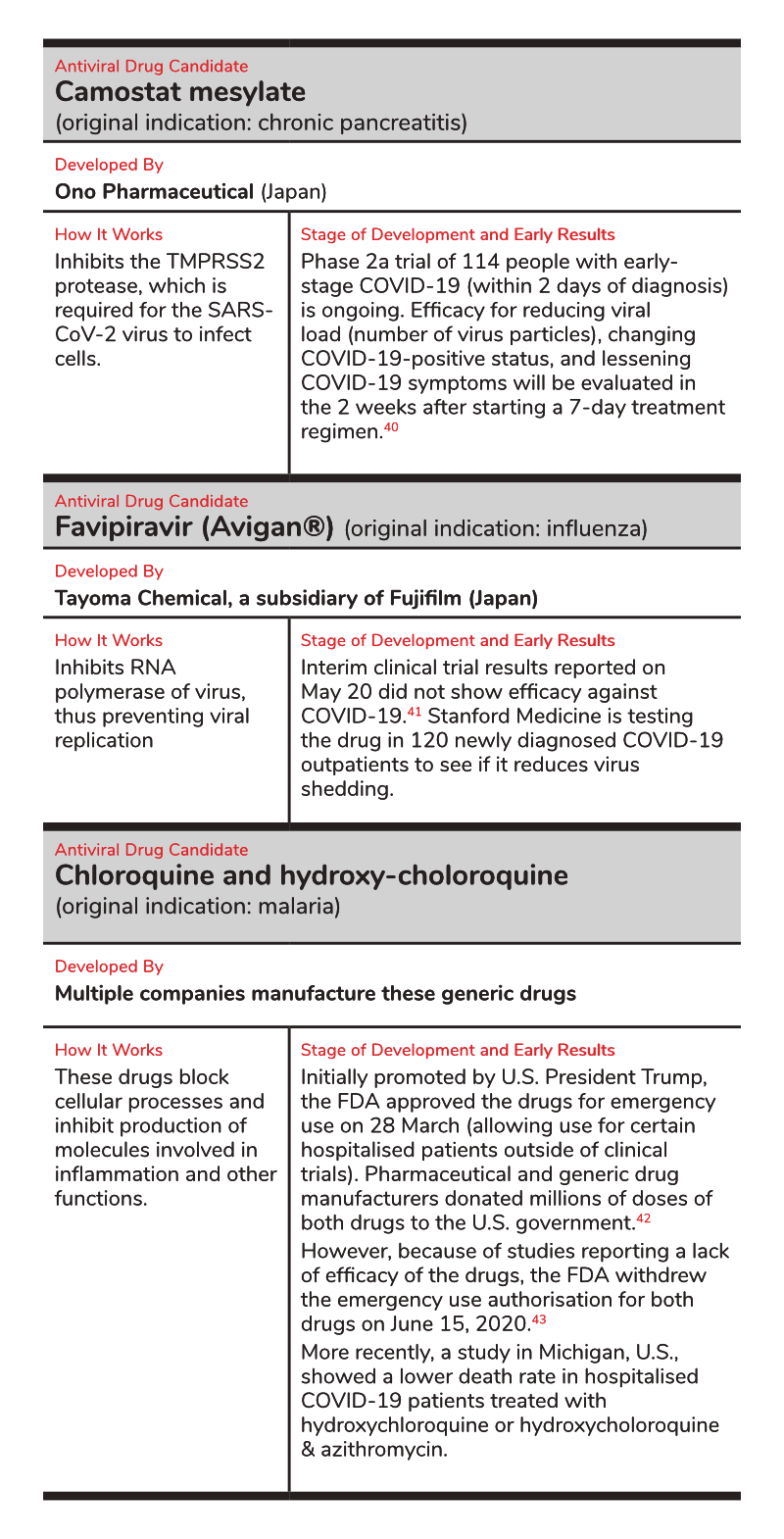
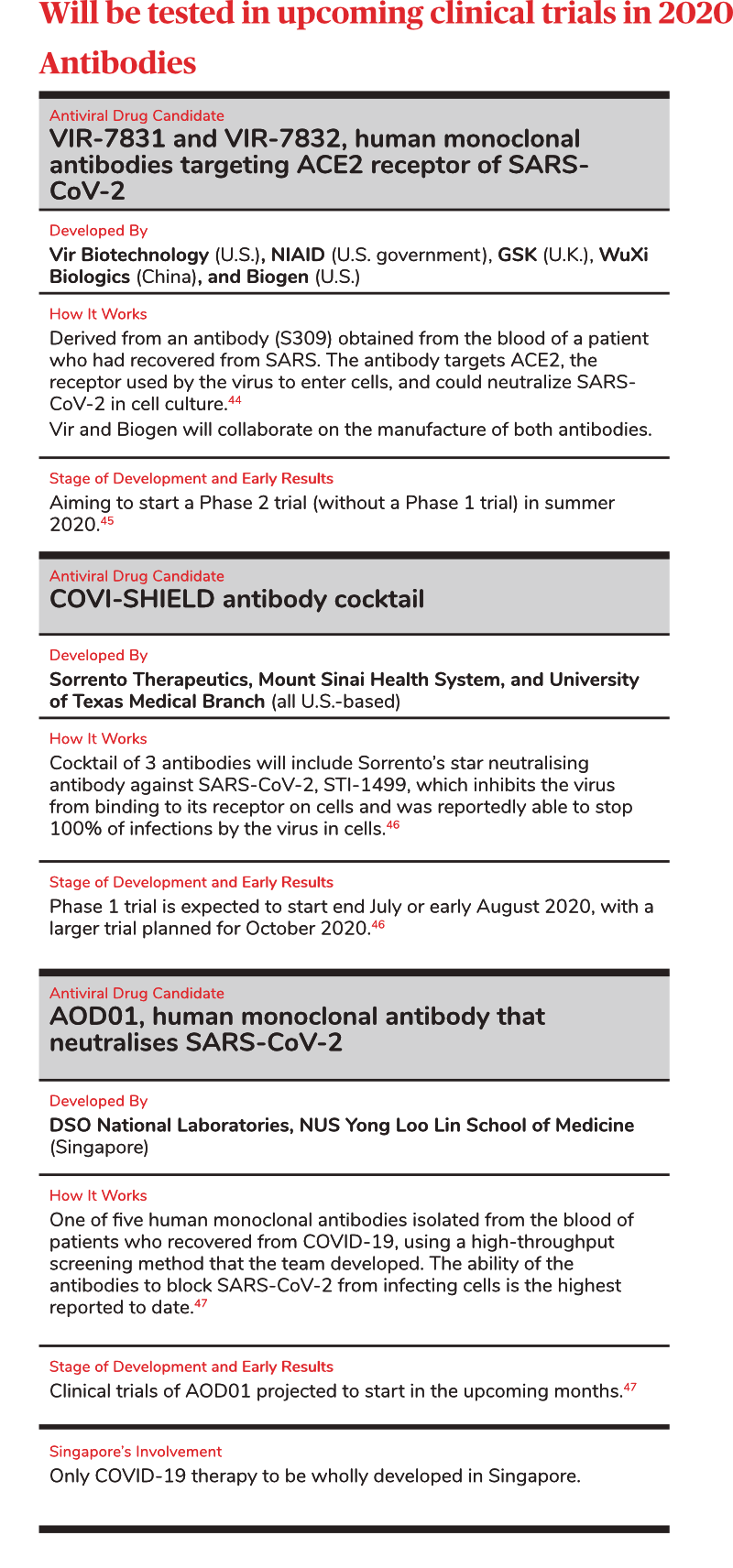
So where does that leave us?
Despite the extremely rapid pace at which COVID-19 vaccine and drug candidates are being developed, more time is needed to properly test the most promising candidates in clinical trials. At the moment, some of the brightest antiviral stars on the horizon are remdesivir and dexamethasone, which have been around for a while. Although remdesivir is approved for emergency use for COVID-19 by the FDA (meaning it can be used in certain patients in hospitals outside of clinical trials), it would likely take at least several months before it is approved for more widespread use. A COVID-19 vaccine will take longer, partly because almost all of the candidate vaccines are new and have never been used before. Many experts think it will be early- to mid-2021 at the earliest (12 to 18 months after SARS-CoV-2 was first characterised) before a COVID-19 vaccine is available.48
REFERENCES
1 Wu Z, McGoogan JM. Characteristics of and important lessons from the Coronavirus Disease 2019 (COVID-19) outbreak in China: summary of a report of 72314 cases from the Chinese Center for Disease Control and Prevention. J Am Med Assoc. 2020;323:1239-1242.
2 Wang D, Hu B, Hu C, et al. Clinical characteristics of 138 hospitalized patients with 2019 novel coronavirus-infected pneumonia in Wuhan, China. J Am Med Assoc. 2020;323:1061-1069.
3 Liu K, Fang YY, Deng Y, et al. Clinical characteristics of novel coronavirus cases in tertiary hospitals in Hubei Province. Chin Med J (Engl). 2020;133:1025-1031.
4 U.S. Food & Drug Administration. Step 3: Clinical Research. https://www.fda.gov/patients/drug-development-process/step-3-clinical-research#Clinical_Research_ Phase_Studies. Accessed June 30, 2020.
5 Callaway E. The race for coronavirus vaccines: a graphical guide. Nature. [News Feature]. April 28, 2020.
6 World Health Organization. Accelerating a safe and effective COVID-19 vaccine. https://www.who.int/emergencies/diseases/novel-coronavirus-2019/global-research-on-novel-coronavirus-2019-ncov/accelerating-a-safe-and-effective-covid-19-vaccine. June 29, 2020. Accessed June 30, 2020.
7 Wrapp D, Wang N, Corbett KS, et al. Cryo-EM structure of the 2019-nCoV spike in the prefusion conformation. Sceince. 2020;367:1260-1263.
8 Channelnewsasia. Reasons for hope: the drugs, tests and tactics that may conquer COVID-19. April 14, 2020. https://www.channelnewsasia.com/news/world/covid-19-cure-drugs-vaccines-therapies-tests-coronavirus-12639912.
9 Hodgson J. The pandemic pipeline. Nat Biotech. 2020;38:523-532.
10 Novavax identifies coronavirus vaccine vandidate; accelerates initiation of first- in-human trial to mid-May [news release]. Gaithersburg, MD, USA: Novavax; April 8, 2020. https://www.globenewswire.com/news-release/2020/04/08/2013404/0/en/Novavax-Identifies-Coronavirus-Vaccine-Candidate-Accelerates-Initiation-of-First- in-Human-Trial-to-Mid-May.html. Accessed June 3, 2020.
11 Castaneda R. Clover’s adjuvant choice for Covid-19 an edge, but comparison with IMV’s, Novavax’s vaccines limited. GlobalData Healthcare. May 28, 2020.
12 Zhu F-C, Li Y-H, Guan X-H, et al. Safety, tolerability, and immunogenicity of a recombinant adenovirus type-5 vectored COVID-19 vaccine: a dose-escalation, open-label, non-randomised, first-in-human trial. The Lancet. May 22, 2020. Epub ahead of print.
13 Jackson LA, Anderson EJ, Rouphael NG, et al. An mRNA vaccine against SARS- CoV-2–Preliminary Report. N Engl J Med. July 14, 2020. Epub ahead of print.
14 Angus T, Wilson J. In pictures: the Imperial lab developing a COVID-19 vaccine. Imperial News, Imperial College London. March 20, 2020. https://www.imperial. ac.uk/news/196313/in-pictures-imperial-developing-covid-19-vaccine/.
15 Coronavirus: Human trial of new vaccine begins in UK. BBC News. June 24, 2020. https://www.bbc.com/news/health-53061288. Accessed June 30, 2020
16 Adams B. Pfizer, BioNTech to ramp up COVID-19 vaccine tests, plot major trial boost in fall. FierceBiotech. https://www.fiercebiotech.com/biotech/pfizer-biontech- to-ramp-up-covid-19-vaccine-tests-plots-major-trial-boost-fall.
17 ClinicalTrials.gov. Safety, Tolerability and Immunogenicity of INO-4800 for COVID-19 in Healthy Volunteers. https://clinicaltrials.gov/ct2/show/NCT04336410.
18 INOVIO Announces Positive Interim Phase 1 Data For INO-4800 Vaccine for COVID-19 [news release]. Plymouth Meeting, Pennsylvania: Inovio Pharmaceuticals, Inc.; June 30, 2020. https://www.prnewswire.com/news-releases/inovio-announces- positive-interim-phase-1-data-for-ino-4800-vaccine-for-covid-19-301085537. html. Accessed June 30, 2020.
19 Freeman M. San Diego’s Arcturus Therapeutics will get up to $10M from Singapore for coronavirus vaccine. The San Diego Union-Tribune. March 5, 2020. https://www.sandiegouniontribune.com/business/biotech/story/2020-03-05/ arcturus-therapeutics-nets-up-to-10-million-in-funding-from-singapore-for-covid- 19-vaccine. Accessed June 30, 2020.
20 Herper M. Merck leaps into Covid-19 vaccine race, aiming to test two different candidates this year. May 26, 2020. https://www.statnews.com/2020/05/26/ merck-aims-to-begin-human-tests-of-two-different-covid-19-vaccines-this-year/. Accessed June 30, 2020.
21 CureVac’s optimized mRNA platform provides positive pre-clinical results at low dose for coronavirus vaccine candidate [news release]. Tubingen, Germany: CureVac AG; May 14, 2020. https://www.curevac.com/news/curevac-s-optimized- mrna-platform-provides-positive-pre-clinical-results-at-low-dose-for-coronavirus- vaccine-candidate. Accessed June 30, 2020.
22 Johnson & Johnson Announces a Lead Vaccine Candidate for COVID-19; Landmark New Partnership with U.S. Department of Health & Human Services; and Commitment to Supply One Billion Vaccines Worldwide for Emergency Pandemic Use [news release]. New Brunswick, NJ, USA: Johnson & Johnson; March 30, 2020. https: //www.jnj.com/johnson-johnson-announces-a-lead-vaccine-candidate-for- covid-19-landmark-new-partnership-with-u-s-department-of-health-human- services-and-commitment-to-supply-one-billion-vaccines-worldwide-for- emergency-pandemic-use. Accessed June 30, 2020.
23 Sanofi’s response in the fight against COVID-19. Paris, France: Sanofi; 2020. https: //www.sanofi.com/en/about-us/our-stories/sanofi-s-response-in-the-fight- against-covid-19. Accessed June 30, 2020.
24 Clinical Trials Arena. Apeiron Biologics gets regulatory approval for Phase II Covid-19 trial. April 3, 2020. https://www.clinicaltrialsarena.com/news/apeiron- biologics-phaseii-covid-19/. Accessed June 30, 2020.
25 The Straits Times. Arthritis drug tocilizumab shows ‘significant’ promise in severe Covid-19 cases: Study. https://www.straitstimes.com/world/europe/arthritis- drug-tocilizumab-shows-significant-promise-in-severe-covid-19-cases-study. April 28, 2020. Accessed June 3, 2020.
26 ClinicalTrials.gov. A Study to Evaluate the Safety and Efficacy of Tocilizumab in Patients With Severe COVID-19 Pneumonia (COVACTA). https://clinicaltrials. gov/ct2/show/NCT04320615?term=Actemra%2C+COVACTA&cond=COVID- 19&draw=2&rank=1. Accessed June 30, 2020.
27 Roche initiates phase III clinical trial of Actemra/RoActemra plus remdesivir in hospitalised patients with severe COVID-19 pneumonia [news release]. Basel, Switzerland: Roche; May 28, 2020. https://www.roche.com/media/releases/med- cor-2020-05-28.htm. Accessed June 30, 2020.
28 ClinicalTrials.gov. Cohort Multiple Randomized Controlled Trials Open-label of Immune Modulatory Drugs and Other Treatments in COVID-19 Patients – Sarilumab Trial – CORIMUNO-19 – SARI (CORIMUNO-SARI). https://clinicaltrials.gov/ct2/show/ NCT04324073?term=Kevzara&cond=COVID-19&draw=4&rank=7. Accessed June 30, 2020.
29 Blankenship K. After disappointing early numbers, Sanofi and Regeneron scale back Kevzara’s COVID-19 test. FiercePharma. April 27, 2020. https://www. fiercepharma.com/pharma/sanofi-regeneron-scale-back-kevzara-study-after- disappointing-results-severe-covid-19. Accessed June 30, 2020.
30 ClinicalTrials.gov. A Study of LY3819253 (LY-CoV555) in Participants With Early Mild to Moderate COVID-19 Illness (BLAZE-1). https://clinicaltrials.gov/ct2/show/NC T04427501?term=AbCellera&cond=COVID-19&draw=2&rank=1. Updated June 26, 2020. Accessed June 30, 2020.
31 ClinicalTrials.gov. A Study of LY3819253 (LY-CoV555) in Participants Hospitalized for COVID-19. https://clinicaltrials.gov/ct2/show/NCT04411628?term =AbCellera&cond=COVID-19&draw=2&rank=2. Updated June 26, 2020. Accessed June 30, 2020.
32 InflaRx starts dosing Covid-19 patients in Europe. Clinical Trials Arena. April 1, 2020. https://www.clinicaltrialsarena.com/news/inflarx-covid-19-dosing-europe/. Accessed June 3, 2020.
33 Grein J. Ohmagar N, Shin D, et al. Compassionate use of remdesivir for patients with severe Covid-19 [published online ahead of print April 10, 2020]. N Engl J Med. https: //doi.org/10.1056/NEJMoa2007016.
34 Goldman JD, Lye DCB, Hui DS; for the GS-US-540-5773 Investigators. Remdesivir for 5 or 10 days in patients with severe Covid-19 [published online ahead of print May 27, 2020]. N Engl J Med. https://doi.org/10.1056/ NEJMoa2015301.
35 Gilead Announces Results From Phase 3 Trial of Remdesivir in Patients With Moderate COVID-19 [news release]. Foster City, CA, USA: Gilead Sciences; June 1, 2020. https://www.gilead.com/news-and-press/press-room/press-releases/2020/6/ gilead-announces-results-from-phase-3-trial-of-remdesivir-in-patients-with- moderate-covid-19. Accessed June 30, 2020.
36 Beigel JH, Tomashek KM, Dodd LE, et al.; for the ACTT-1 Study Group Members. Remdesivir for the treatment of Covid-19 — preliminary report [published
online ahead of print May 22, 2020]. N Engl J Med. https://doi.org/10.1056/ NEJMoa2007764.
37 Cao B, Wang Y, Liu W, et al. A trial of lopinavir–ritonavir in adults hospitalized with severe Covid-19. N Engl J Med. 2020;382:1787-1799.
38 Blasiak A, Lim JJ, Seah SGK, et al. IDentif.AI: Artificial Intelligence Pinpoints Remdesivir in Combination with Ritonavir and Lopinavir as an Optimal Regimen Against Severe Acute Respiratory Syndrome Coronavirus 2 (SARS-CoV-2). medRxiv. https://www.medrxiv.org/content/10.1101/2020.05.04.20088104v1.full. pdf+html. [Preprint article].
39 RECOVERY Collaborative Group. Effect of dexamethasone in hospitalized patients with COVID-19 – preliminary report. medRxiv preprint. June 22, 2020. https://doi.org/10.1101/2020.06.22.20137273. Accessed June 30, 2020.
40 ClinicalTrials.gov. Camostat Mesylate in COVID-19 Outpatients. https:// clinicaltrials.gov/ct2/show/NCT04353284?term=Camostat&cond=COVID-19&draw=2&rank=1. Updated June 22, 2020. Accessed June 30, 2020.
41 Drug Avigan that was pushed by Abe falls short in COVID-19 trials. The Japan Times. May 20, 2020. https://www.japantimes.co.jp/news/2020/05/20/national/ science-health/avigan-coronavirus-results/#.XtdA_zozY2w. Accessed June 30, 2020.
42 Blankenship K. Mylan prepares hydroxychloroquine giveaways after production ramp-up. FiercePharma. April 9, 2020. https://www.fiercepharma. com/manufacturing/mylan-plans-massive-donations-after-hydroxychloroquine- production-ramp-up. Accessed June 30, 2020.
43 U.S. Food & Drug Administration. Coronavirus (COVID-19) Update: FDA Revokes Emergency Use Authorization for Chloroquine and Hydroxychloroquine. FDA News Release. June 15, 2020. https://www.fda.gov/news-events/press-announcements/ coronavirus-covid-19-update-fda-revokes-emergency-use-authorization- chloroquine-and. Accessed June 30, 2020.
44 Pinto D, Park Y-J, Beltramello, et al. Cross-neutralization of SARS-CoV-2 by a human monoclonal SARS-CoV antibody [published online ahead of print May 18, 2020]. Nature. https://doi.org/10.1038/s41586-020-2349-y.
45 Vir Biotechnology Provides Corporate Update and Reports First Quarter
2020 Financial Results [corporate update]. San Francisco, CA, USA: Vir Biotechnology, Inc.; May 12, 2020. https://www.globenewswire.com/news-release/2020/05/12/2032224/0/en/Vir-Biotechnology-Provides-Corporate-Update- and-Reports-First-Quarter-2020-Financial-Results.html. Accessed June 30, 2020.
46 Romann A, Mak E. Optimistic Sorrento looking to have COVID-19 antibody ready by October. BioWorld. May 28, 2020. https://www.bioworld.com/articles/435404- optimistic-sorrento-looking-to-have-covid-19-antibody-ready-by-october. Accessed June 30, 2020.
47 DSO and NUS scientists identify five potent antibodies to fight COVID-19 [news release]. Singapore: NUS Yong Loo Lin School of Medicine; June 17, 2020. https:// nusmedicine.nus.edu.sg/medias/news-info/2315-dso-and-nus-scientists-identify- five-potent-antibodies-to-fight-covid-19?fbclid=IwAR1y1niY-0xZnVolrBWLv1HfrlU mqagGQLvTULzeN6VosoxgOg8Cmu6SPgE. Accessed June 30, 2020.
48 Gallagher J. Coronavirus vaccine: when will we have one? BBC News. May 18, 2020. https://www.bbc.com/news/health-51665497. Accessed June 30, 2020.
